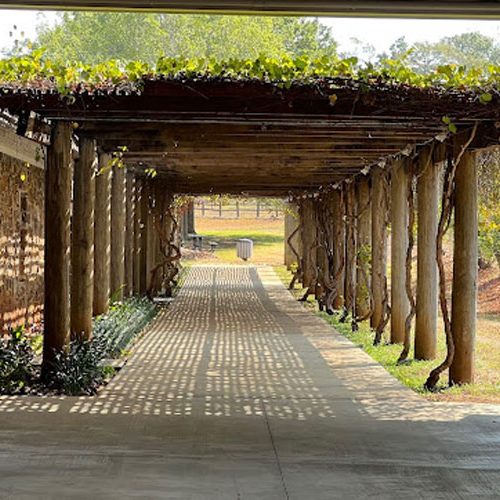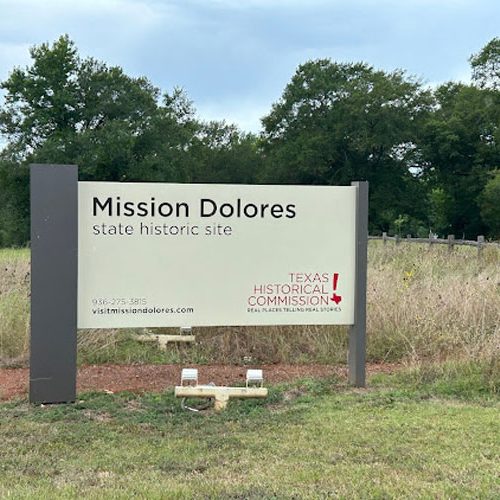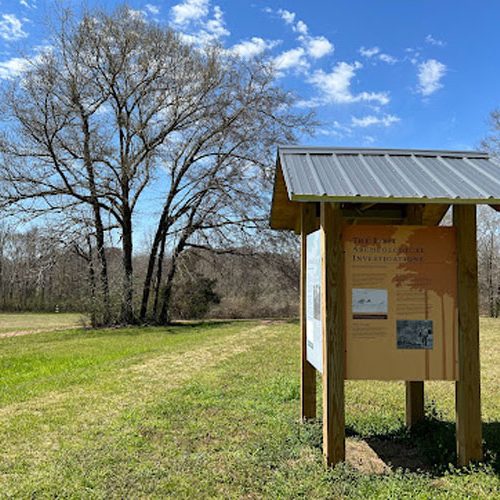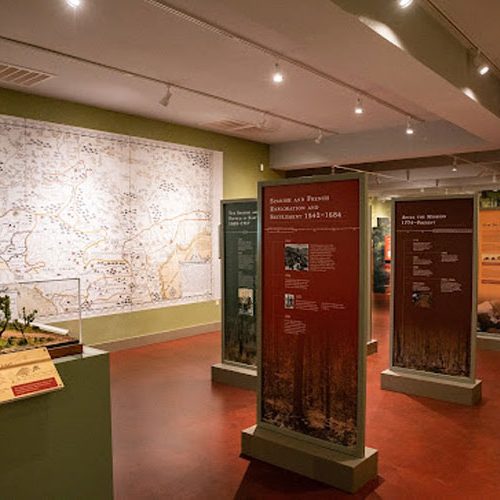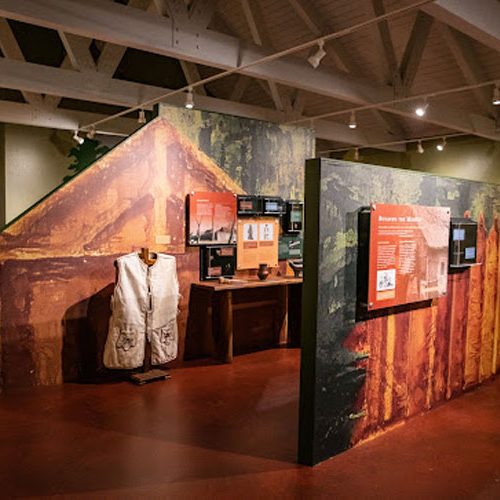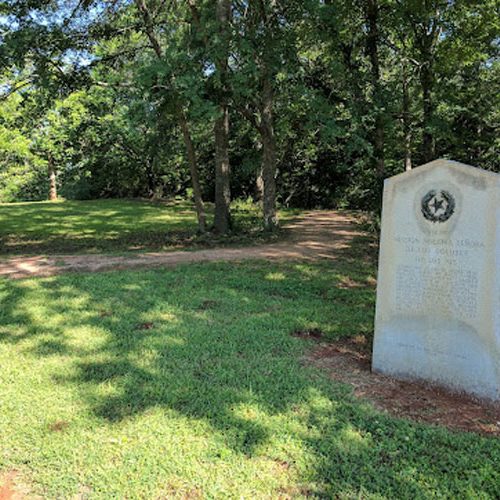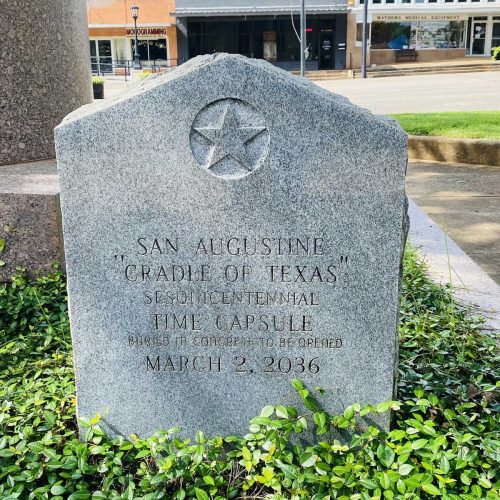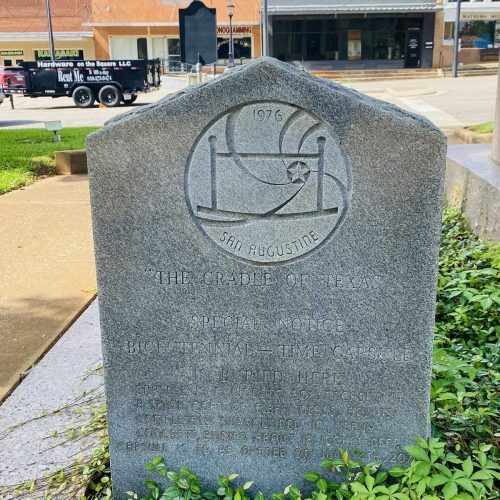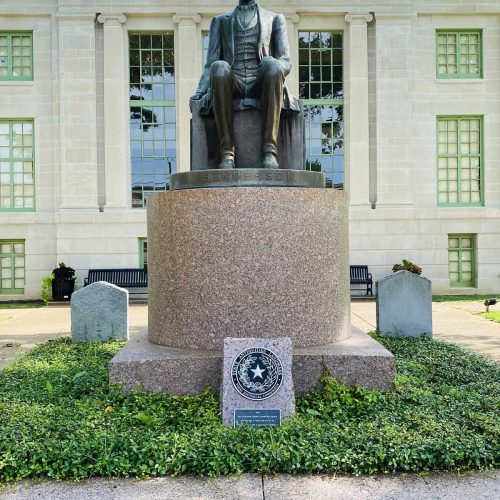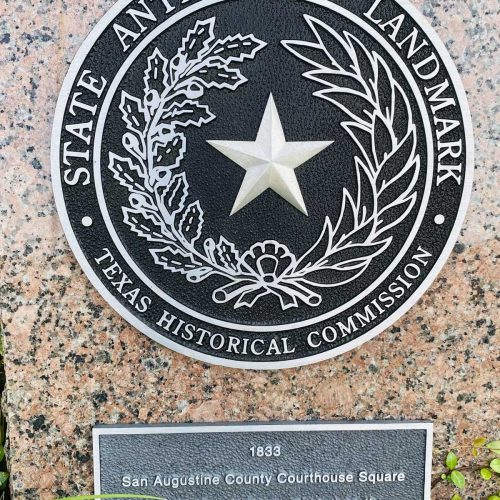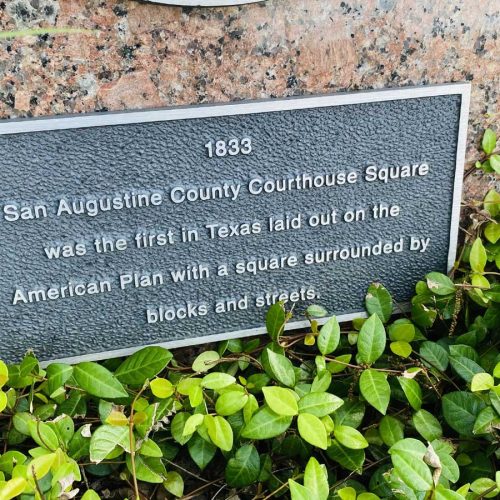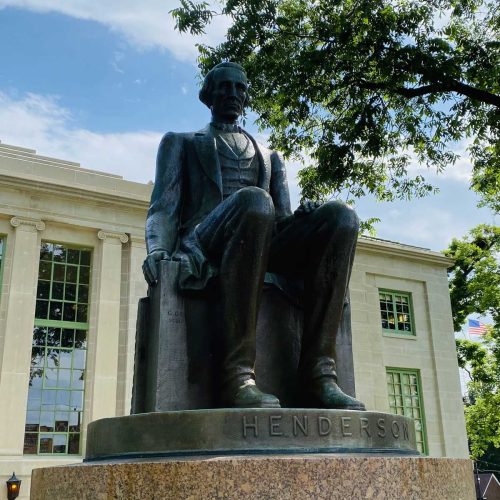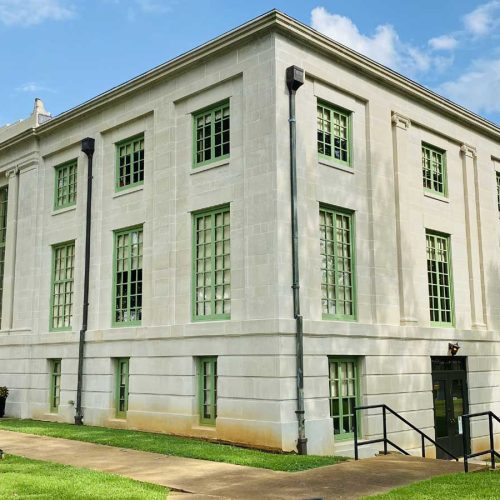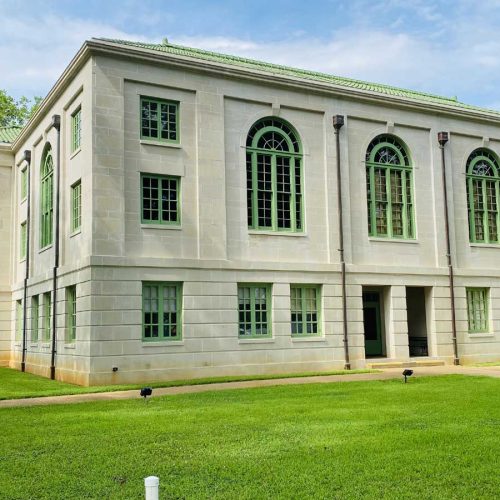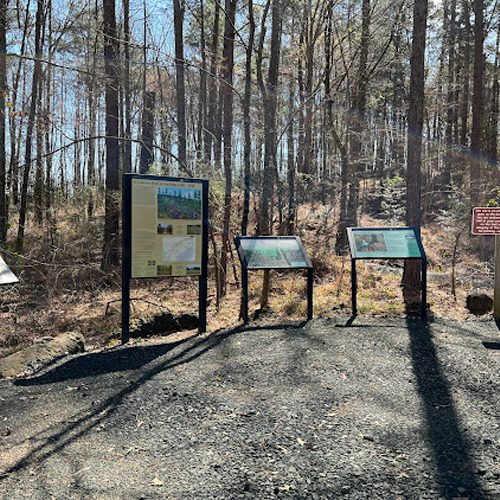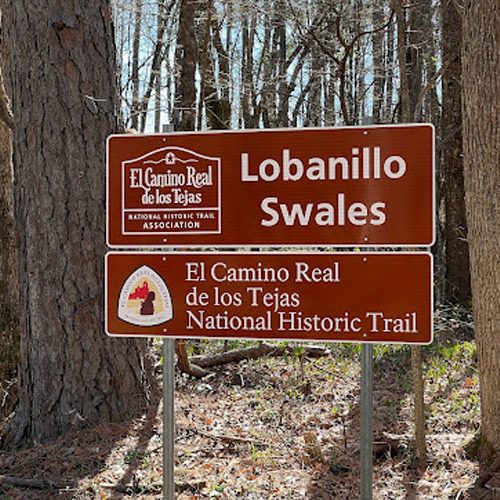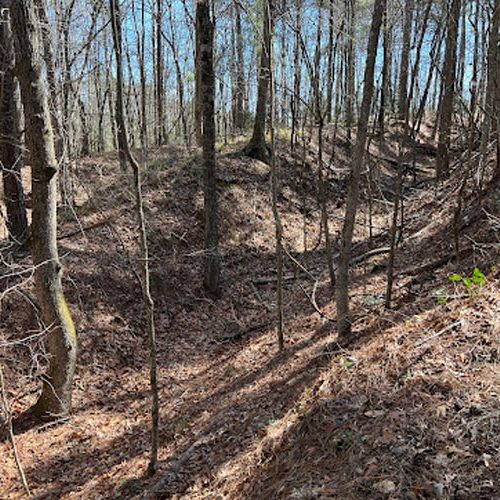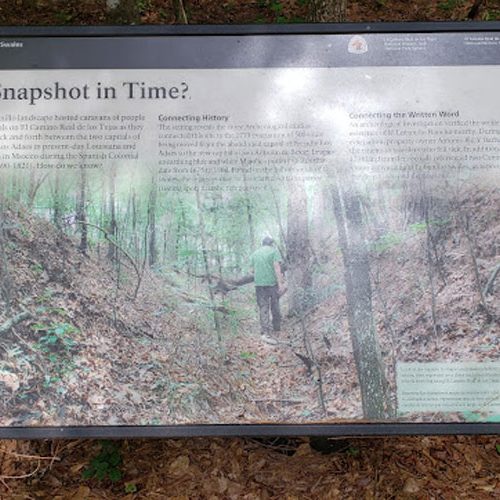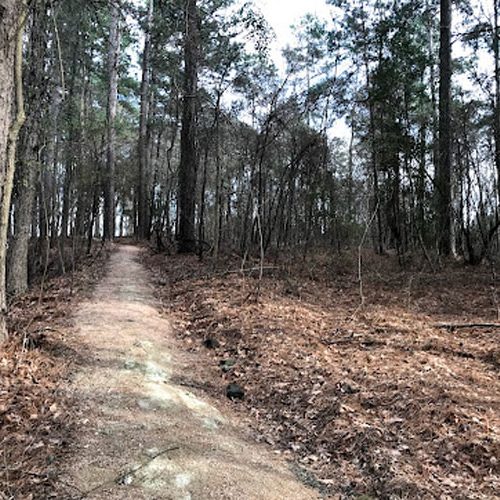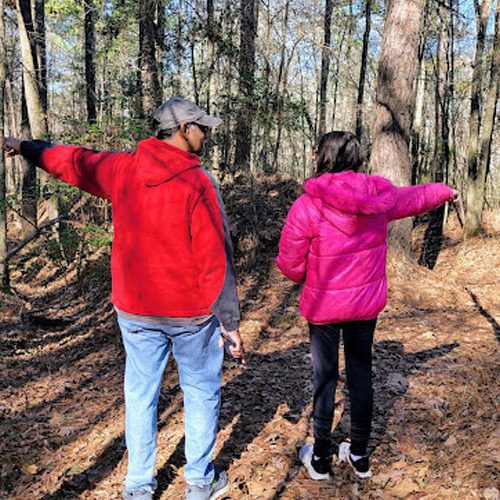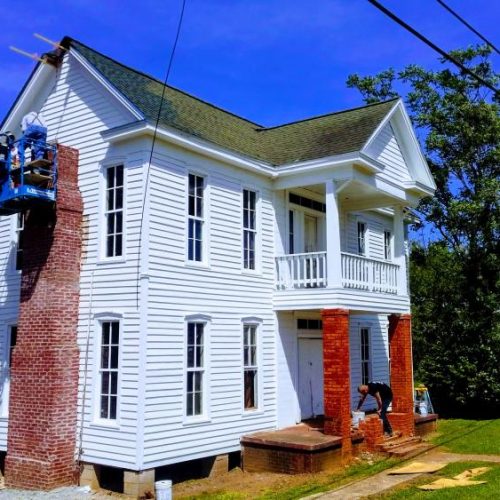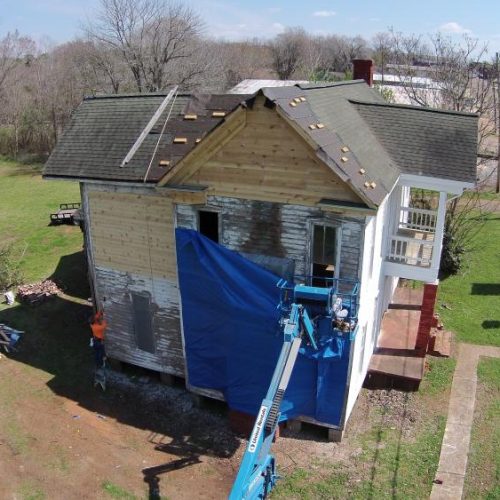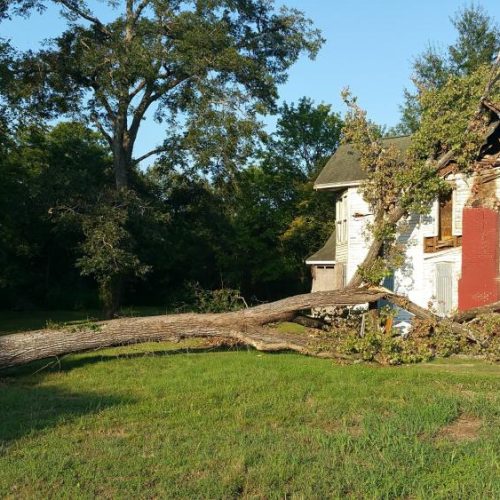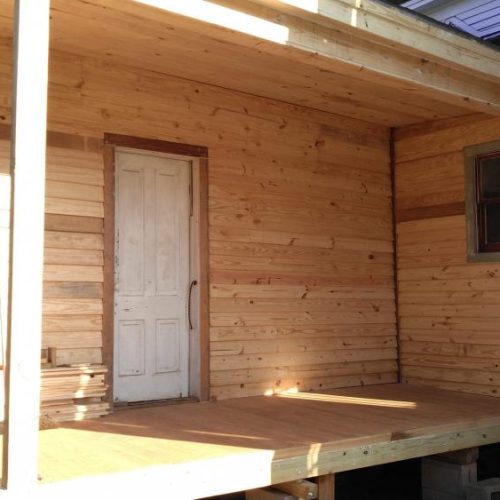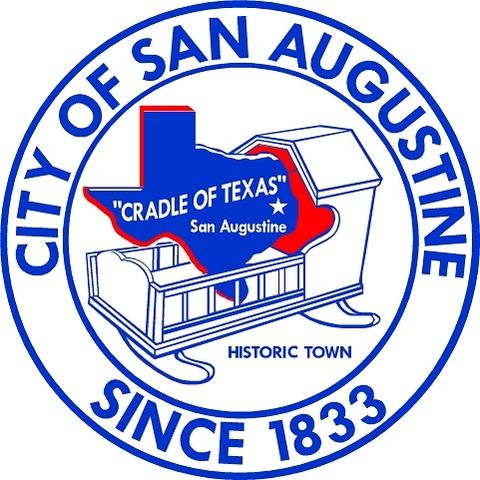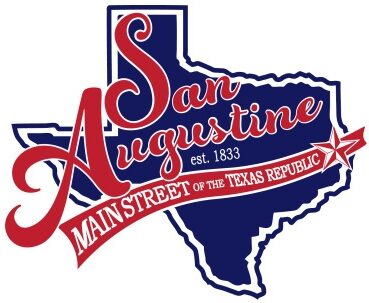Local Attractions
Mission Dolores State Historic Site
Mission Dolores State Historic Site was a Spanish mission built in 1721 in what is now San Augustine County, just 20 miles west of the Texas-Louisiana border. The site explores the history of the Spanish experience with the East Texas Native Americans and the French settlers in western Louisiana. Listed in the National Register of Historic Places, visitors can explore the site’s rich history at the museum where interpretive displays tell the real story.
The property also has an RV Park, picnic areas, and group pavilions.
701 South Broadway St. San Augustine, TX 75972
Located on South Broadway Street, half a mile south of downtown San Augustine on the right.
936-275-3815
Tuesday-Sunday, 8 a.m.-5 p.m.
1919 San Augustine County Jail
This interesting 100-year-old jail served San Augustine County until the year 2000, when the sheriff’s office moved to the John W. Mitchell Law Enforcement Center two blocks from the courthouse square. Later, the San Augustine County Probate Office was in the old jail, but relocated inside the restored San Augustine County Courthouse due to health concerns.
In 1973 the jail had been coated with two layers of concrete-like stucco, eventually becoming a moldy, abandoned eyesore. Through the efforts of San Augustine Garden Club, interested citizens, and friends of San Augustine, the 1919 jail was restored and repurposed as a Law Enforcement Museum celebrating the lives and service of early Alcaldes, Sheriffs, Judges, Texas Rangers, Game Wardens, Highway Patrol, and City Police. The building, completed in the year 2017, with re-dedication ceremonies held on March 2, 2018, has Recorded Texas Historic Landmark, National Register, and State Antiquities Landmark designations.
Inside The Restored Jail:
- The Texana research library
- County records research just for you!
- Rolling history kiosk featuring photographs taken by Russell Lee in 1939 and John Vachon during World War II during their visits to San Augustine
- Timelines in the history of San Augustine and the 1717/1721 Mission Dolores
- Items relating to San Augustine county available for purchase
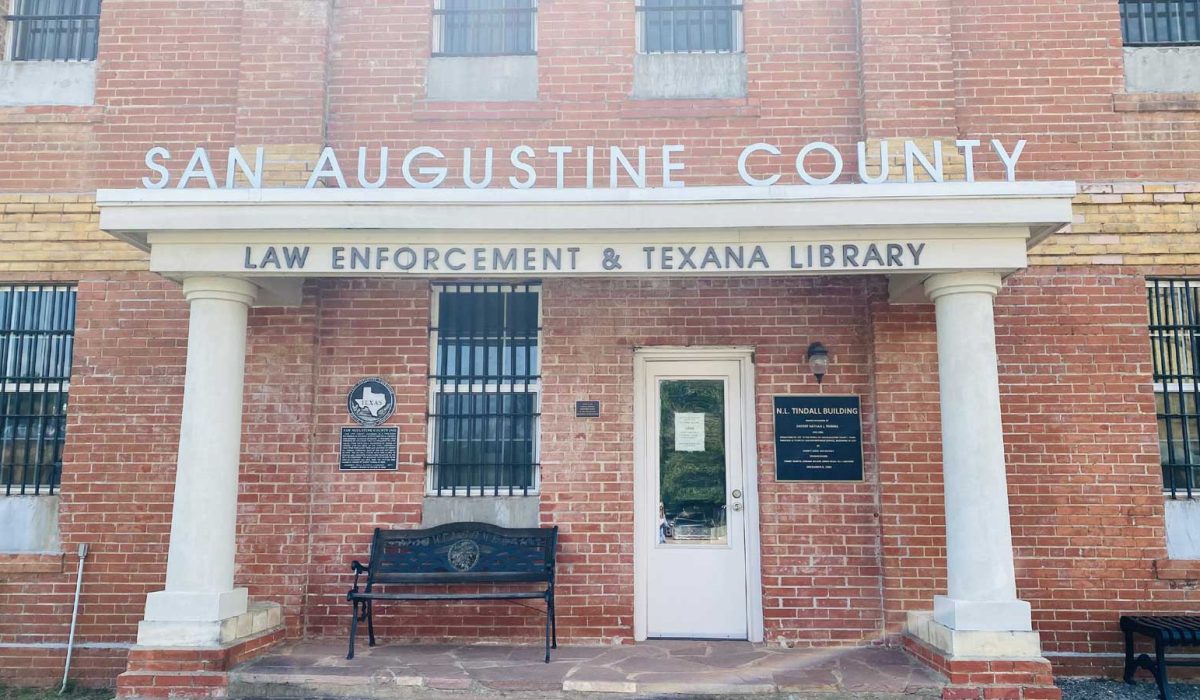
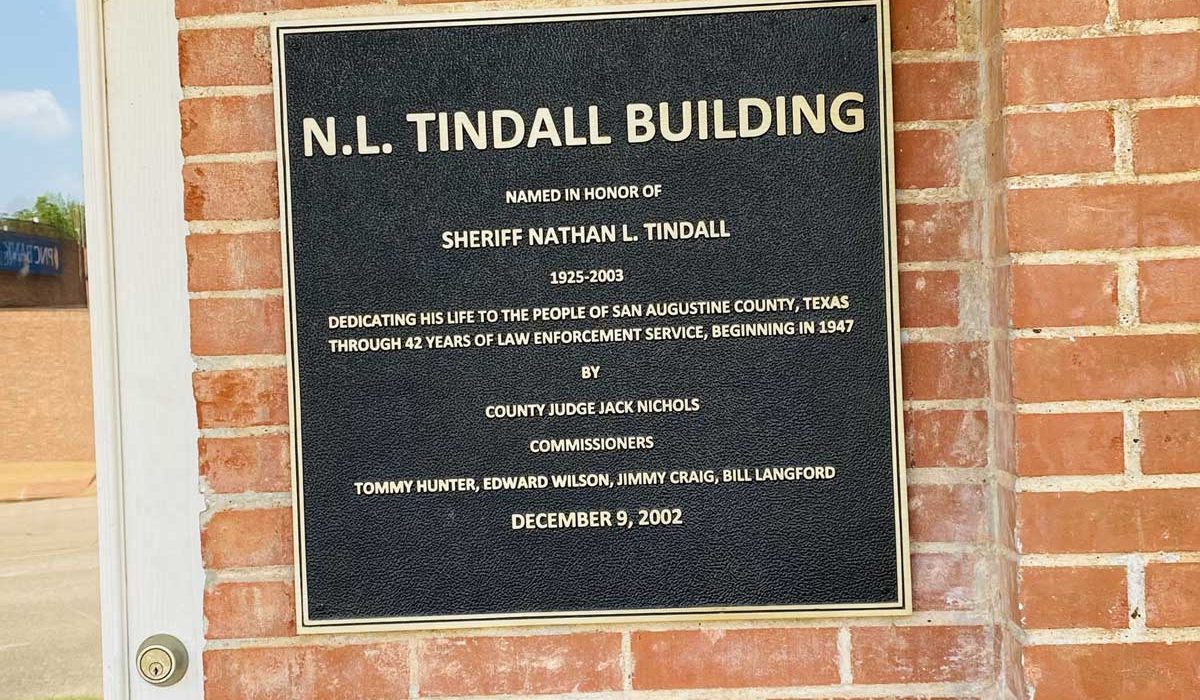
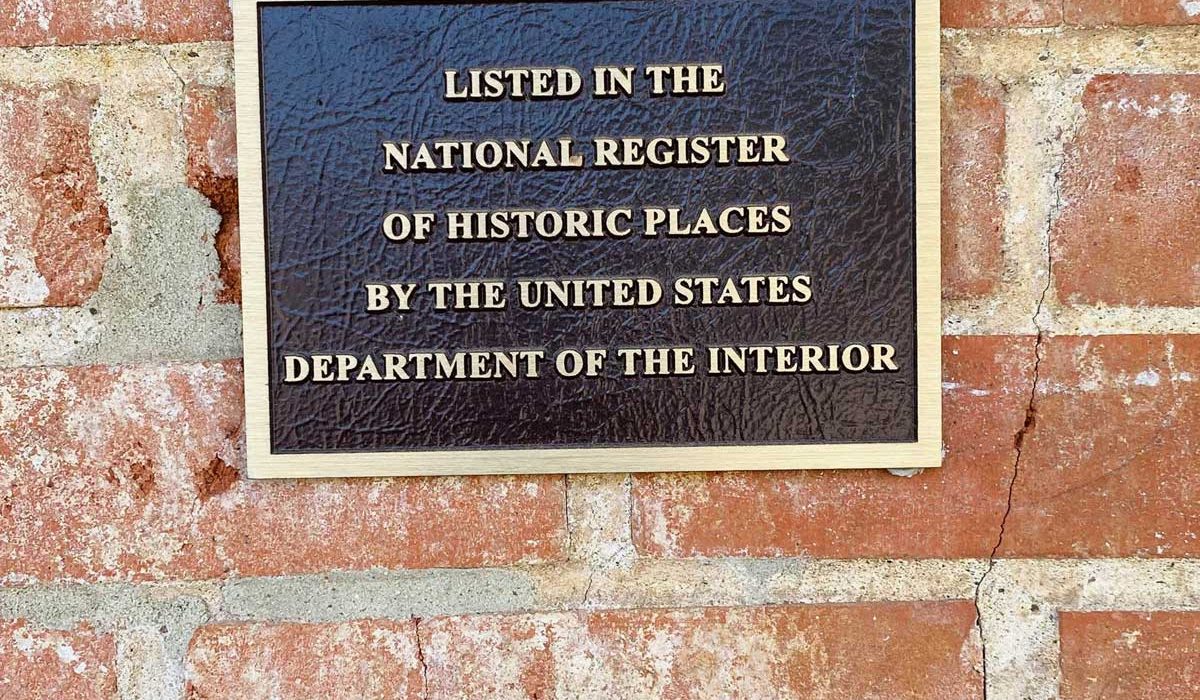
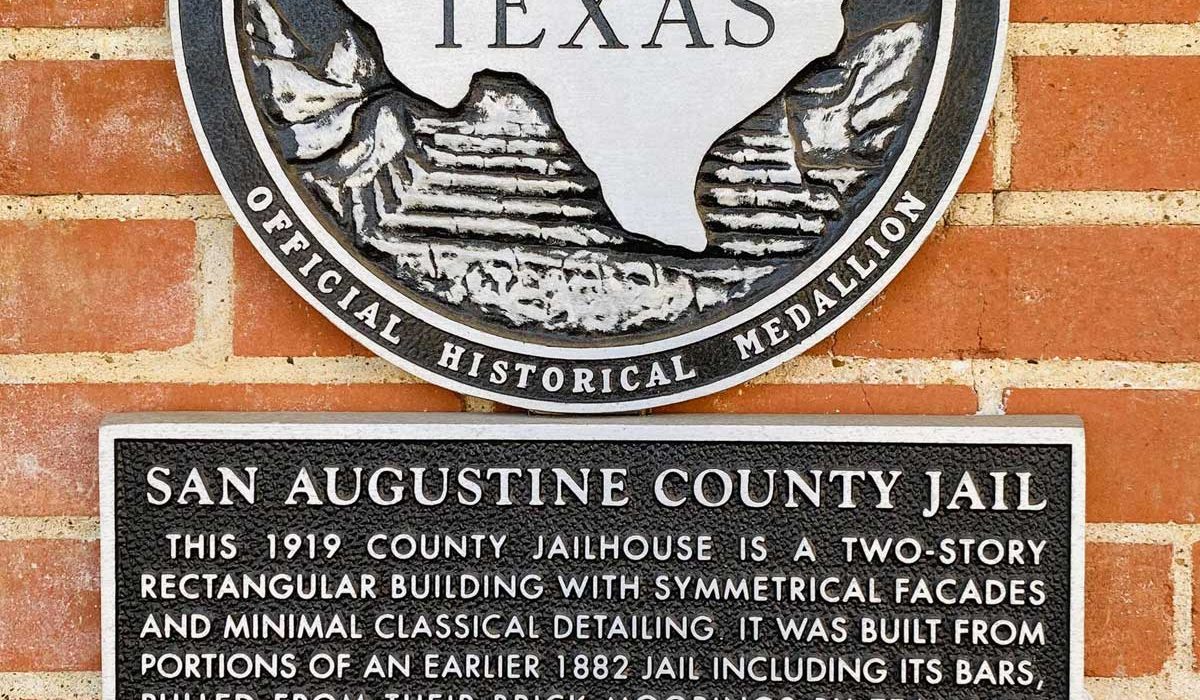
Windows Into History
Going on throughout 2025
Through the Windows into History visitors can journey back in time to witness the first Europeans setting foot near the Ayish Bayou and learn about the Ais Indians who once thrived here. The story of Mission Dolores, established in 1717, unfolds alongside the rich history of El Camino Real, the King’s Highway that traversed from Natchitoches, LA to Mexico City, passing right through San Augustine. The tales of Davy Crockett’s visit, the notorious 1830s gunfight over a land dispute, and the involvement of the Texas Rangers in our town are brought to vivid life. You can also uncover 15 unique “firsts” attributed to San Augustine and delve into the legacy of the Timber Industry, the iconic Cullen House, and the heyday of Bland Lake, a popular recreational hotspot in the early 1900s. Experience the delightfully furnished 1930s dollhouse, learn about the history of our local newspaper, the Tribune, and witness the changes that came to East Texas with the arrival of electricity. See the Sinclair Station famously photographed by Russell Lee, and enjoy the narrative of generations of a farming family. Delight in the artist’s rendition and the story of Mr. Weathered and his mules.
Take a stroll around the square. Windows into History is an artistic three-dimensional tour that breathes life into San Augustine’s vibrant past. Conceived and created by local artists, artisans, and historians, this project is a celebration of our deep roots in Texas history.
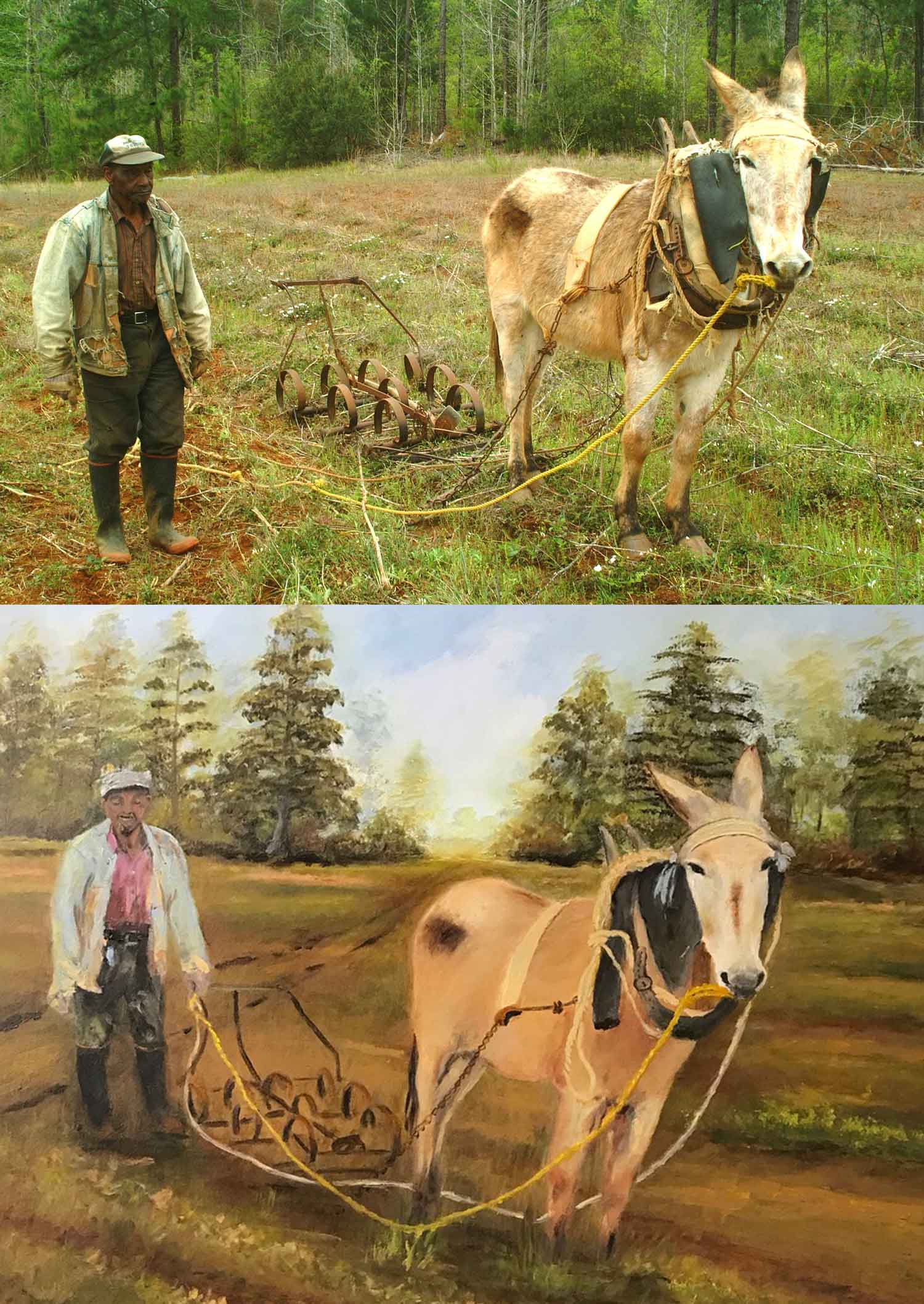
“Man with Mules and Plows” – this window display, painted by Jean Hines of San Augustine, features Mr. Earl Weathered who spent his whole life farming without modern conveniences, truly living off the land.
Visit the Courthouse Square
Walk around the courthouse square with its statue of Governor James Pinckney Henderson. Existing records (now digitalized) hold accounts of unusual trials, including the only trial for treason ever held in the Texas Republic. Walk the streets where feuds sometimes erupted in gunfire, where gamblers and scoundrels walked beside gentlemen and soldiers, farmers and jurists. The old jail is preserved on Montgomery Street (now a private office).
The Big Thicket National Preserve
The Big Thicket National Preserve is an easy drive from San Augustine, offering a paradise for hikers, campers, birders and wildflower enthusiasts.
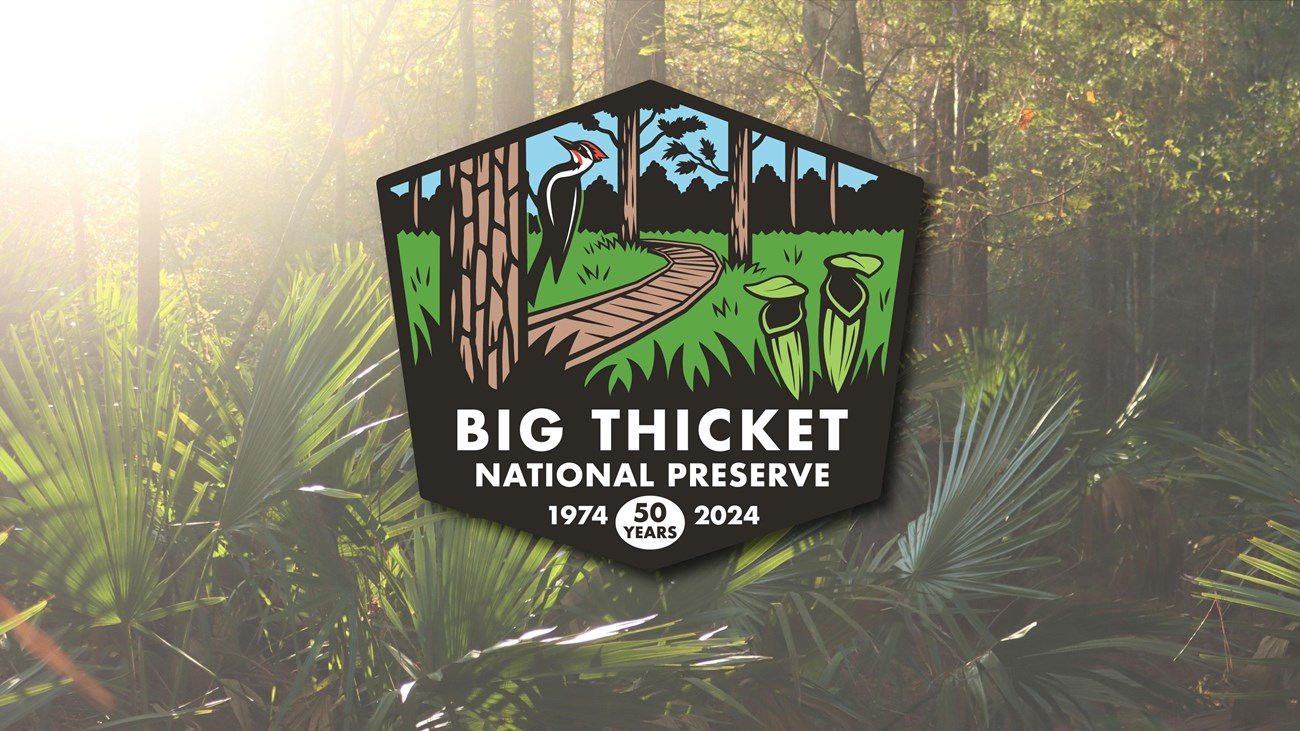
Lobanillo Swales
This attraction is part of the El Camino Real de los Tejas National Historic Trail. The designation of this Historic Trail commemorates significant historic routes extending from the United States-Mexico international border at the Río Grande to the eastern boundary of the Spanish province of Texas in Natchitoches Parish, Louisiana.
The Lobanillo Swales, Located Just Outside Of San Augustine
Has two sets of deep and parallel swales that extend about one-quarter mile through the forest. One set of swales has seven parallel ruts reaching a depth of eighteen-feet and twelve-feet wide. A state historic marker in nearby Geneva says that the historic Spanish rancho known as El Lobanillo was located nearby. The rancho included the pueblo of Gil Y’Barbo (1729-1809), a refuge used by his ailing mother and other refugees in 1773, when Spain evacuated colonists from western Louisiana and East Texas. It was given as a land grant to Juan Ignacio Pifermo in 1794, and inherited in the early 1800s by John Maximillian (ca. 1778-1866).
Information provided by: www.elcaminorealdelostejas.org
Historic Homes & Churches
In 2002, the Texas State Society of Architects designated San Augustine one of the twenty-five places termed “Locations where architecture, natural beauty, and cultural heritage combine to create a special corner of the Lone Star State. Places Texans and non-residents revisit again and again.”
State-designated Historic Houses and Historical Markers throughout San Augustine County trace the journey of Texas from Spanish Mission to frontier settlement under Spain, and from town under Mexico to a center of Independent Texas. Enjoy this visual tour of the beautiful town we call home.
Ezekiel Cullen House (205 5. Congress)
The home of Ezekiel Cullen, known as the father of Texas Education for his role in establishing the State’s public schools, is one of three remarkable houses built in San Augustine by Augustus Phelps during the the town’s heyday.
This home was built in 1839 and is listed on the National Register of Historic Places. It is one of the finest examples of Greek Revival Architecture to be found anywhere.
Now owned by the Daughters of the Republic of Texas, the Cullen House is today a museum, housing a fine collection of paintings by Seymour Thomas. Known both nationally and abroad, Thomas was a native of San Augustine.
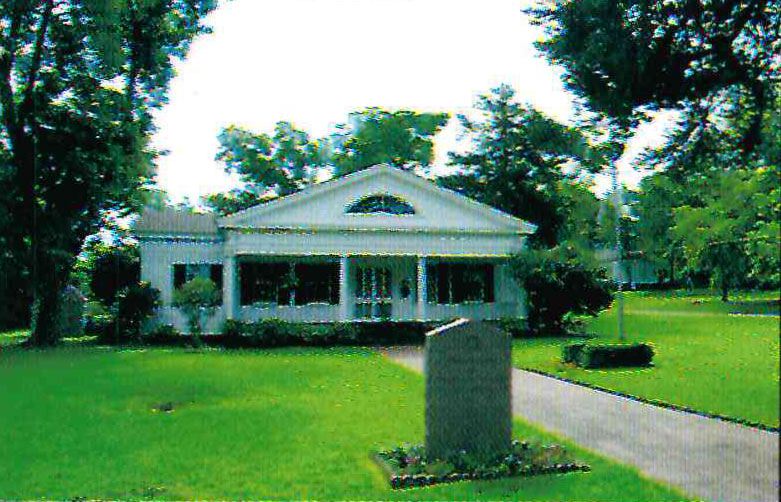
Colonel Stephen William Blount House (502 E. Columbia)
The home was built in 1839 by Augustus Phelps for Stephen W. Blount, a signer of the Declaration of Texas Independence. An excellent example of Greek Revival from its central block flanked by low wings is a Palladian form. The correctness of detail in the entrance porch and cornice, in which a bold Doric order is used, make the home one of the more interesting of the Greek Revival forms surviving today. The home is owned and lived in by Mr. and Mrs. Ray R. Stripling.
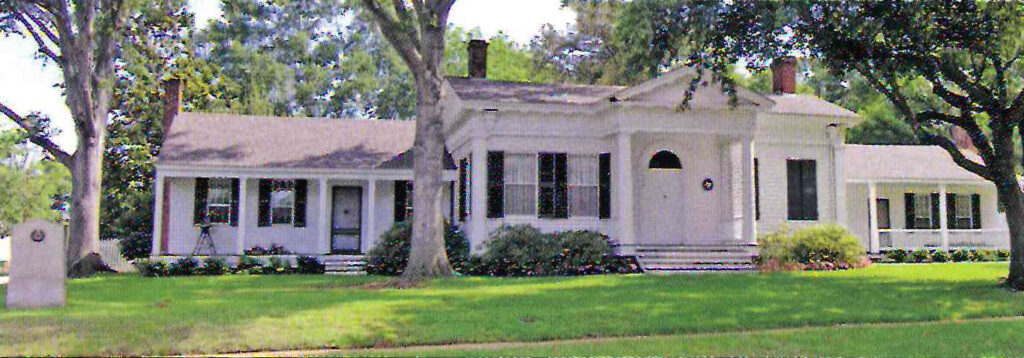
Matthew Cartwright House (912 Main Street)
Known as the Matthew Cartwright House, the home was built in 1839 for Isaac Campbell by Augustus Phelps. After Campbell’s death, the house was sold to Matthew Cartwright in 1847. A large two story building, it is said to be representative of the finest early Greek Revival forms in Texas. Augustus Phelps was known for his patterns of fine moldings and detail as well as the correct proportions of his orders. The Matthew Cartwright House is no exception. Listed on the National Register, it is owned by Minti Cartwright Kardell descendents.
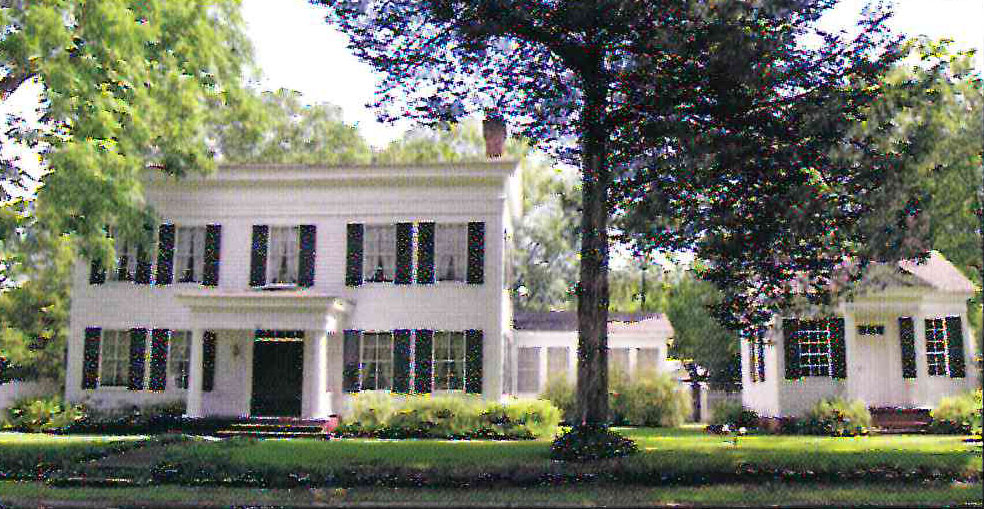
William Garrett Plantation, 1861 (1 mile west on Highway 21)
Known as the “House of Seven Gables,” the home was built by the slaves of William Garrett during the Civil War from hand planed lumber and molded nails. Of special interest are the perfectly matched twelve inch boards from heart-of-pine used throughout the house. The oversized dormers in the roof and the twelve-light windows on the first floor kept the house cool in summer while the six fireplaces with their chimneys made of hand cut rock kept the house warm in the winter. Listed on the National Register, the home is owned by descendents of Mr. and Mrs. C.T. Dorsey.
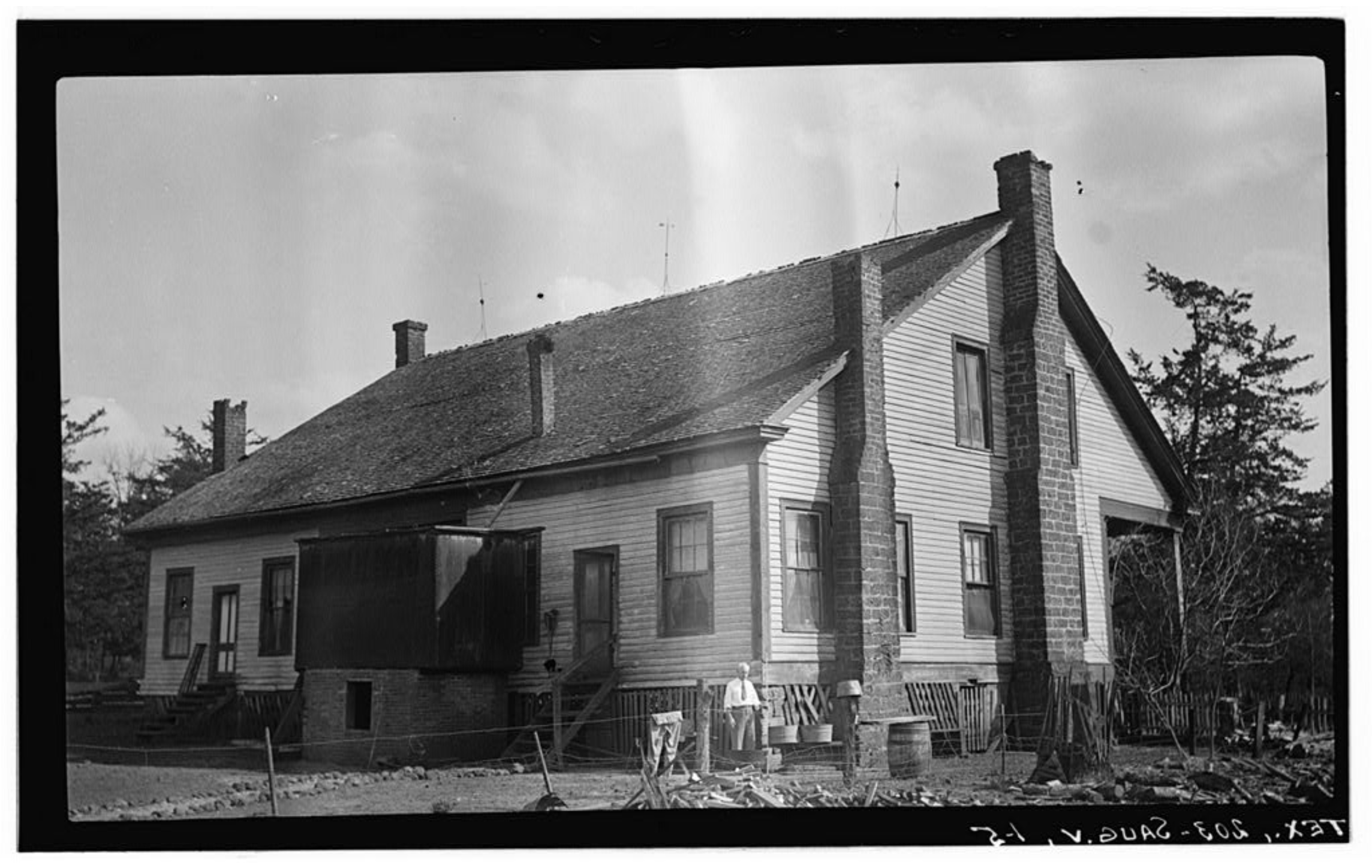
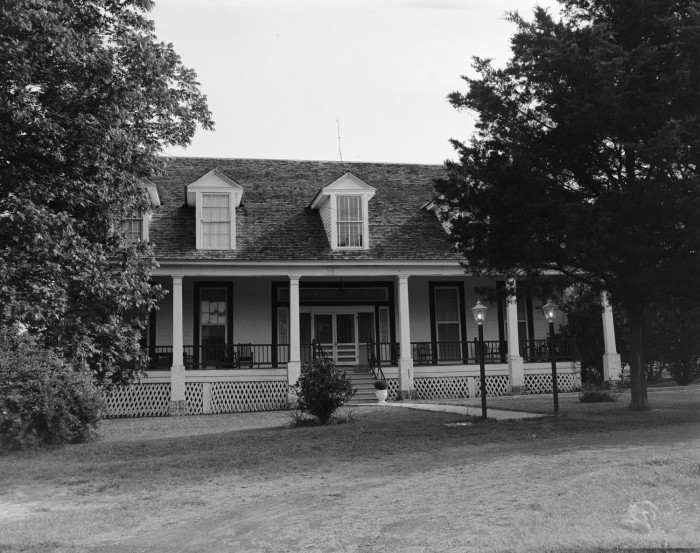
Sublett House (4 miles east on Highway 21)
Although known as the Col. Phillip A. Sublett Home, the present house was actually built by his son in 1874. It is a large two story structure with an ell running to the rear. Of special interest is “the addition of lonic detail in the portico and pedimented cornices over the windows. Also of interest is the change in size of windows from the first to second floor. The home is owned and lived in by Mrs. Jane Sublett. Her late husband, Henry Sublett, is buried in the family cemetery near the historic home.
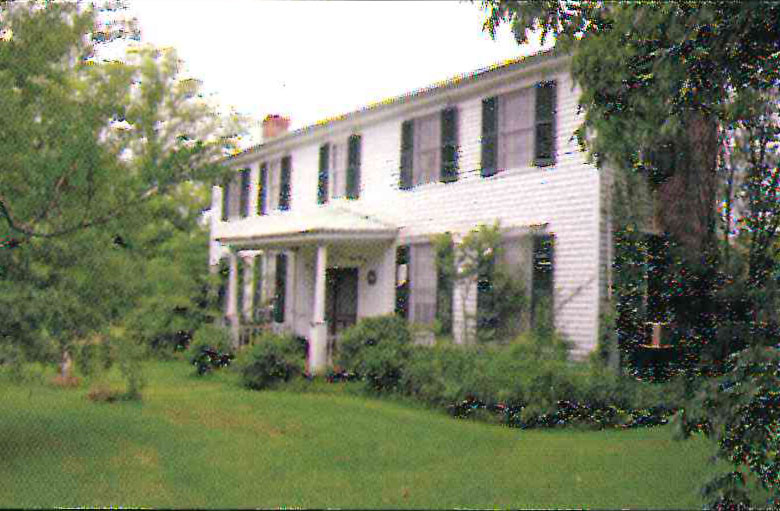
St. Augustine Catholic Church (Corner of Harrison and Market Streets)
By far the oldest church in San Augustine, the history of St. Augustine Catholic Church dates back to the establishment of Mission Nuestra Senora de los Dolores do los Ais. When the Catholic Church was reorganized after the Texas Revolution, the Church in San Augustine became a mission within the Sacred Heart Parish of Nacogdoches in the diocese of Galveston Houston.
The first building at the present location, which was built in 1881, was replaced in 1937. At that time the name of the Church was changed to St. James.
On September 29, 1966, the Church in San Augustine became a part of the newly created diocese of Beaumont. On August 28, 1975, after 259 years as a mission, the Church was established as a vicariate seat. At that time, the name of the Church was officially changed back to the St. Augustine Catholic Church.
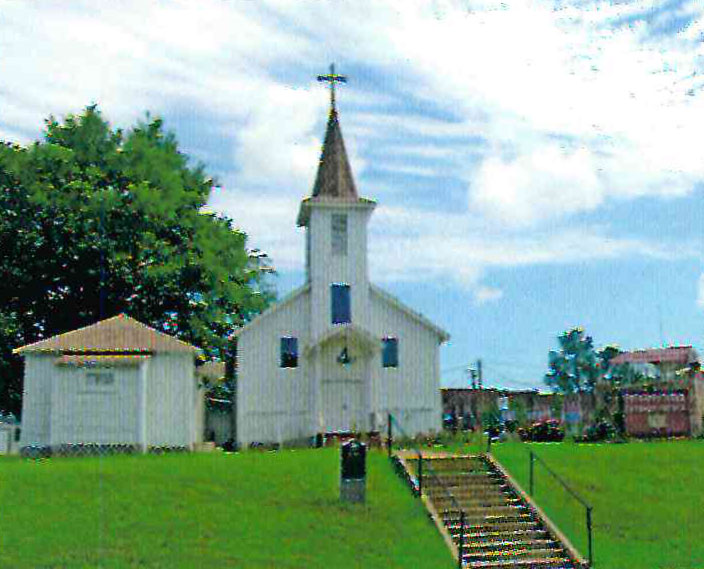
Christ Episcopal Church (201 South Ayish)
The history of the Episcopal Church in San Augustine as an organized body begins in 1848. The person who was directly responsible for the beginning of the church work in the town was Mrs. Frances C. Henderson, wife of General J.P Henderson, the First Governor of Texas.
It was at the insistence of Mrs Henderson that the Rev. Henry Samson was sent in April, 1848, to do missionary work in San Augustine and Nacogdoches.
Mr. Samson’s first service was the burial of his oldest child, who died of scarlet fever the day after the family arrived in San Augustine. The child’s remains are interred under the church altar.
In 1851, three years after the establishment of the Church in 1848, a brick, Gothic style church building was constructed. However, the Church fell in a storm in 1859, and with it was lost the stained glass windows and the organ. Saved were the altar, lectern, rails pews, altar plate, and linens. The property was lost in litigation.
When in, 1869, a movement was started to build a new church, Mr. George F.Crockett donated the land on which the Church now stands, and Col. Stephen W. Blount donated the lumber and shingles. On Christmas, 1870, the first service was held in the new building, which has been in constant use since. Determined that this building would stand, the builders used boxed walls thoroughly braced on both sides. In 1891, the Gothic tower was added to relieve the building of the strain of the vibration of the bell. In the Church are the original rails and hand hewn pews and the lovely carvings of the Rev. George Crockett.
In 1990, the interior of the historic church was repainted through a gift from the estate of Mrs. Summerfield G. Roberts whose relatives worshipped here. A gift from the Edward Clark family made possible manufacture of lighting fixtures of the 1869 period fabricated from one of the original fixtures found in the Church.
The lighting fixtures were dedicated as the Anne Metcalf Clark Memorial Lights In 1991.
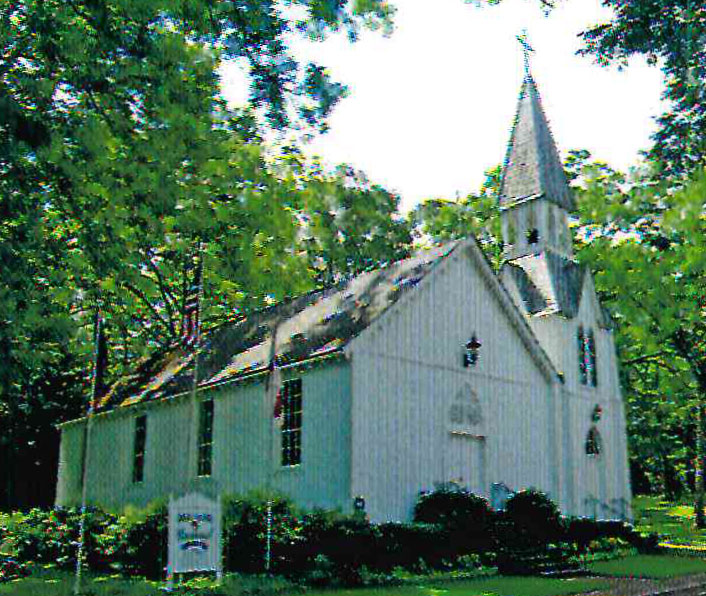
First United Methodist Church (Corner of Main and Liberty Streets)
Littleton Fowler, one of the first Methodist missionaries sent to Texas, arrived in San Augustine on October 19, 1837. Within two weeks trustees had been appointed, a lot had been donated, $3,525 had been subscribed, and a contract had been made for a building The cornerstone was officially laid on January 17, 1838. It was a grand occasion which was “supervised by the Masonic Lodge with speeches by Littleton Fowler and General Thomas Rusk. Rev. Fowler described the occasion as one of moral grandeur, calculated to excite deep and strong feelings in the bosom of every patriot and Christian. The occasion also marked the first time a cornerstone was laid for a church through the foreign missions of the Methodist Church of the United States, a distinction for which the First United Methodist Church is very proud.
The first building which was across the street from the present location and which was built by Augustus Phelps was completed by May 22, 1841. That building served the congregation for the rest of the century.
In 1897, Columbus Cartwright gave the entire block on the south side of the street to the Church with a provision that “place for hitching horses, and standing room for buggies, and other vehicles…” be provided. That was the beginning of the building program for the current building which was completed by 1909. The first building was built under the guidance of Rev. Littleton Fowler. The second or current building was completed while his son Rev. Littleton Morris Fowler, was minister.
Of special interest are the beautiful stained glass windows in the sanctuary which were restored prior to 1960. And, yes-there is a hitching post where you can hitch your horse and plenty of room to park your buggy.
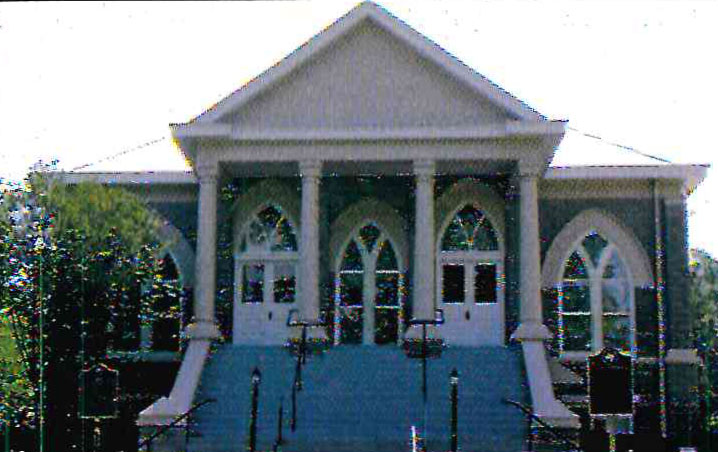
Jerusalem C.M.E. Church (Corner of Livingston and Goldenway)
Organized by 1845 and originally known as the little Church on the Branch, the Jerusalem C.M.E. Church is the oldest black church of record in the state of Texas. The first church was a small, one-room house with a round top which was also used for a school. It was located on the branch or, more specifically, on Lot No. 9 of the town of San Augustine.
In 1870 when the Methodist Episcopal Church, South organized its black churches into a separate organization known as the colored Methodist Episcopal Church, the little “Church on the Branch” was reorganized by the Rev Sam Horton. At that time, the name of the Church was changed to Jerusalem C.M.E. Church.
The little Church which began as the “Church on the Branch” continued worshipping the Lord. Even after the Civil War it resisted the missionary efforts of the northern Methodist Episcopal Church and other independent bodies. The black Methodists of San Augustine chose to remain a part of the Methodist Episcopal Church, South and, to this day, enjoy a unique relationship with the white Methodists of San Augustine.
Church tradition is that Brother Morton Maples gave the lot where the Church is now located. Tradition also maintains that the building was first built there in 1882. Regardless, title to the present property was acquired from Bro. Maples in 1889, and the property of the original site was sold on October 4, 1892, by Morton Maples, John Hall, and J. M. Hightower, trustees of the Colored Methodist Episcopal Church of America.
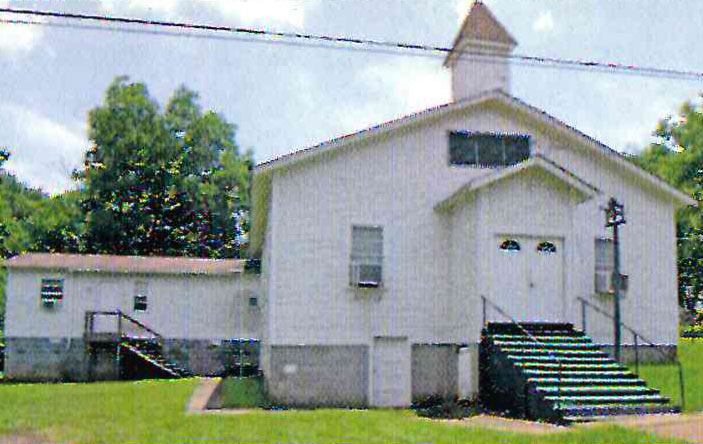
Memorial Presbyterian Church (205 East Livingston)
The Memorial Presbyterian Church was organized June 2, 1838, by the Rev. Hugh Wilson, Missionary of the General Assembly of the Presbyterian Church of the United States of America. The Church was organized with twenty-two charter members at Goodlaw’s School House located four miles west of San Augustine. It was originally organized as the Bethel Presbyterian Church.
In November 1840, with the coming of Rev. John M. Becton, the place of meeting for the Church was changed to San Augustine. The name of the Church was changed from Bethel to San Augustine at that time.
The Church has been continuous since its organization, although, at one time, the membership was down to one member, Mrs. Polly Nicholson, wife of Elder John Nicholson. During the Civil War period, Mrs. Nicholson stood alone, but she steadfastly refused to let the Presbytery dissolve the Church. Soon after the Civil War the Church began to prosper again and, today, it is the oldest Presbyterian Church in Texas.
The present sanctuary was built under the leadership of Rev. D. A. McRae in 1887. At that time, it was renamed Memorial Presbyterian Church in memory of the early pioneers. Funds for its erection came from all over the Synod of Texas.
The three pulpit chairs which are in the Church today were given by Miss Fanny Rankin in 1887. The hand-made pulpit upon which the guest book now rests was used until recent years. Two of the hand-made pews are to be found in the little room to the right of the sanctuary. A copy of the original Session Minutes are available on the old communion table in front of the sanctuary.
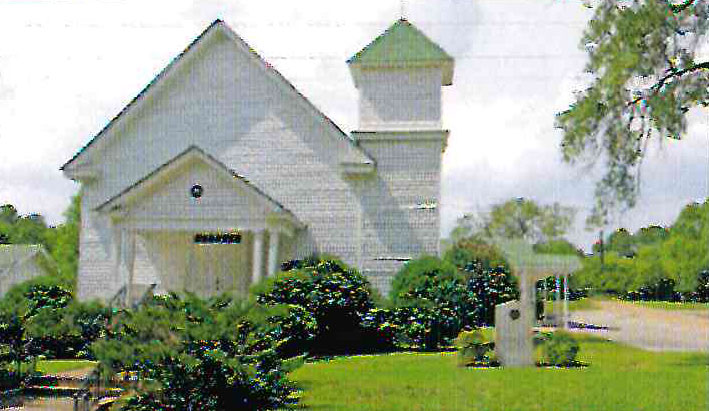
Cabin On The Bayou
On the Banks of the Ayish Bayou stately “Cabin on the Bayou” which houses both the San Augustine Civic & Tourism Center and the San Augustine County Chamber of Commerce. As you approach from the West, the Court of Nine Flags proudly waves a warm welcome to visitors.
The “Cabin on the Bayou” contains two meeting rooms, Scout Room and a fully equipped kitchen.
The T.L.L. Temple Room is surrounded by gold-leaf paintings depicting history of San Augustine. The magnificent paintings are the work of famed Florida artist Salagandi. Over the mantel of the rock fireplace, is “Uncle Sam”, a splendid carving of the Great American Eagle in flight with his 6’10” wings. Noted East Texas Woodcarver, Joe Ladner of San Augustine, dedicated Uncle Sam to all Eagle Scouts from San Augustine.
Across the “Dog Trot” from the T. L. L. Temple Room is the Citizens Room beautifully decorated for club meetings, teas, or other activities.
The building has large covered porches and a wooden swing out back, making the Log Cabin a great venue for both indoor and outdoor events. The rear porch opens onto an expansive grass lawn that slopes down to Ayish Bayou, crossed by an elevated boardwalk with a gazebo entrance. The boardwalk extends over the Bayou and into Sante Fe Park with the charmingly rustic Ayish Hall, across from the historic Lewis Hotel. A 1/3 mile nature trail winds through the woods, beginning at the small wooden bridge near the caboose and terminating at South Broadway, Highway 147 just south of Mission Dolores.
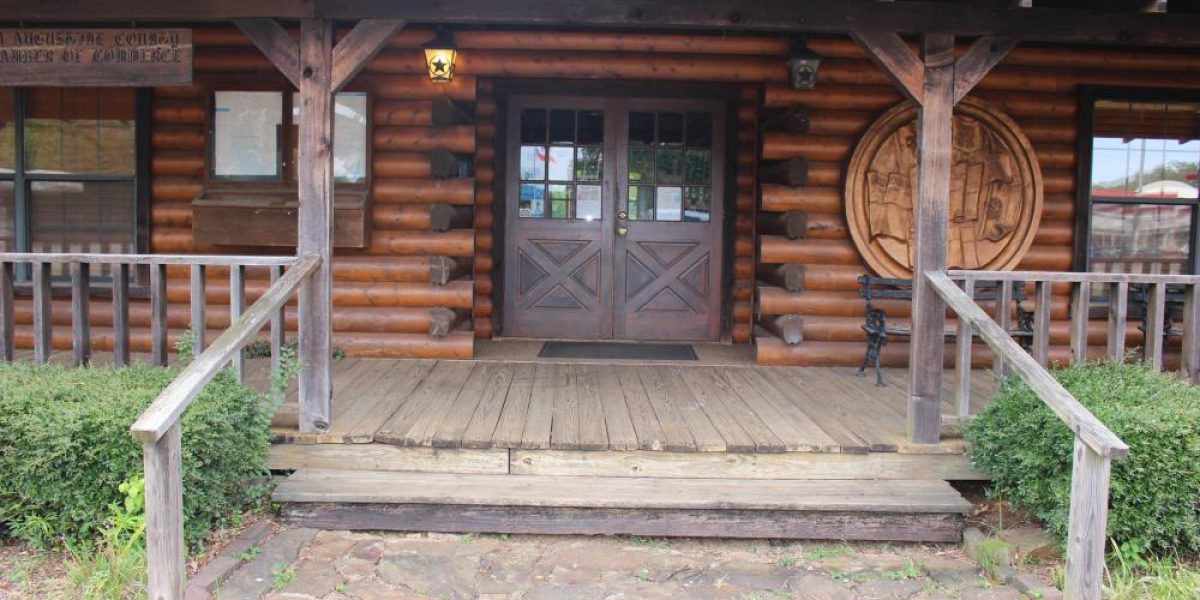
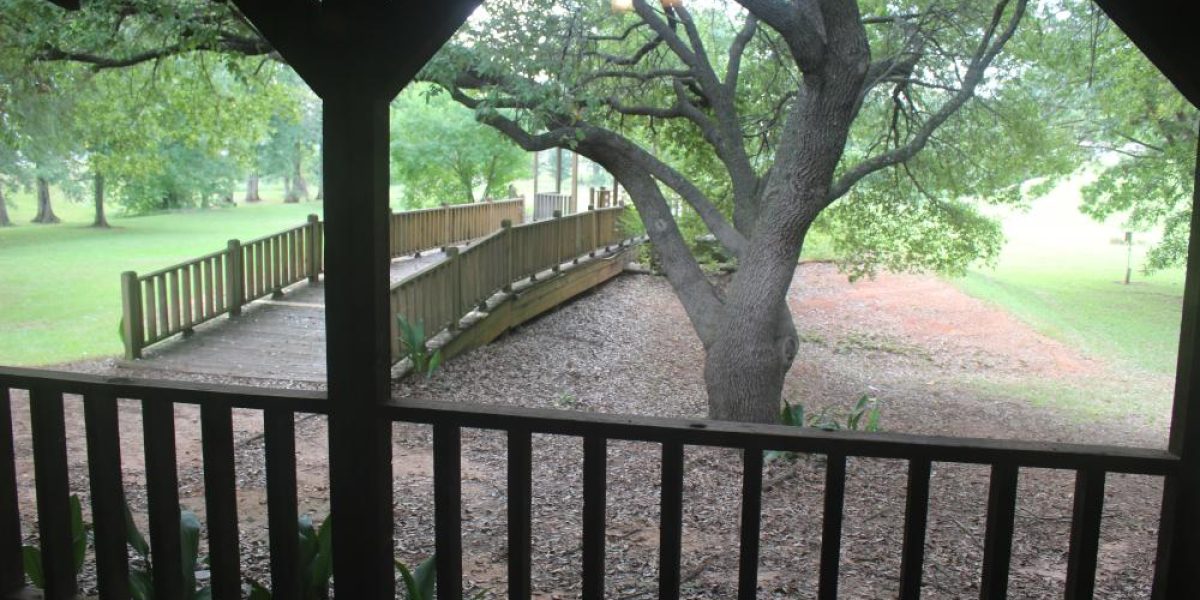
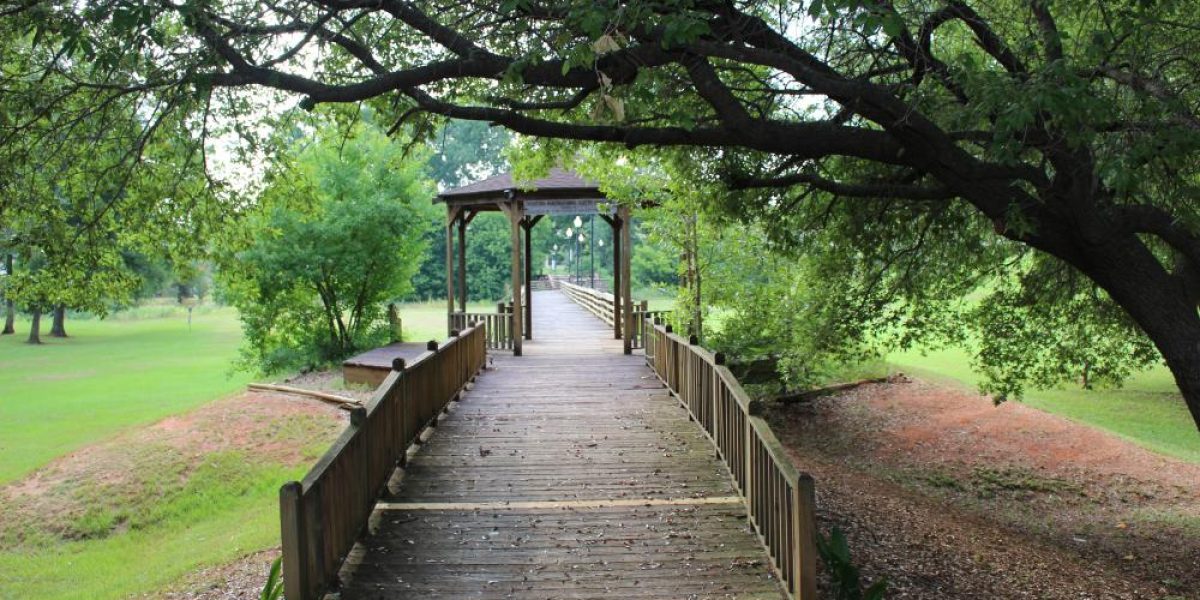
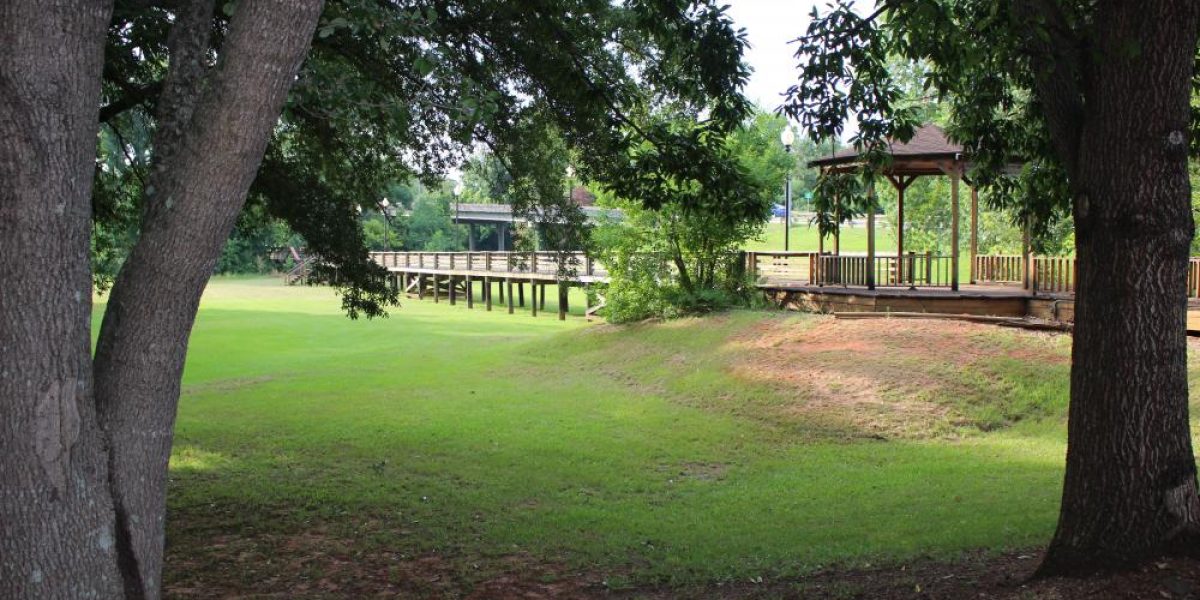
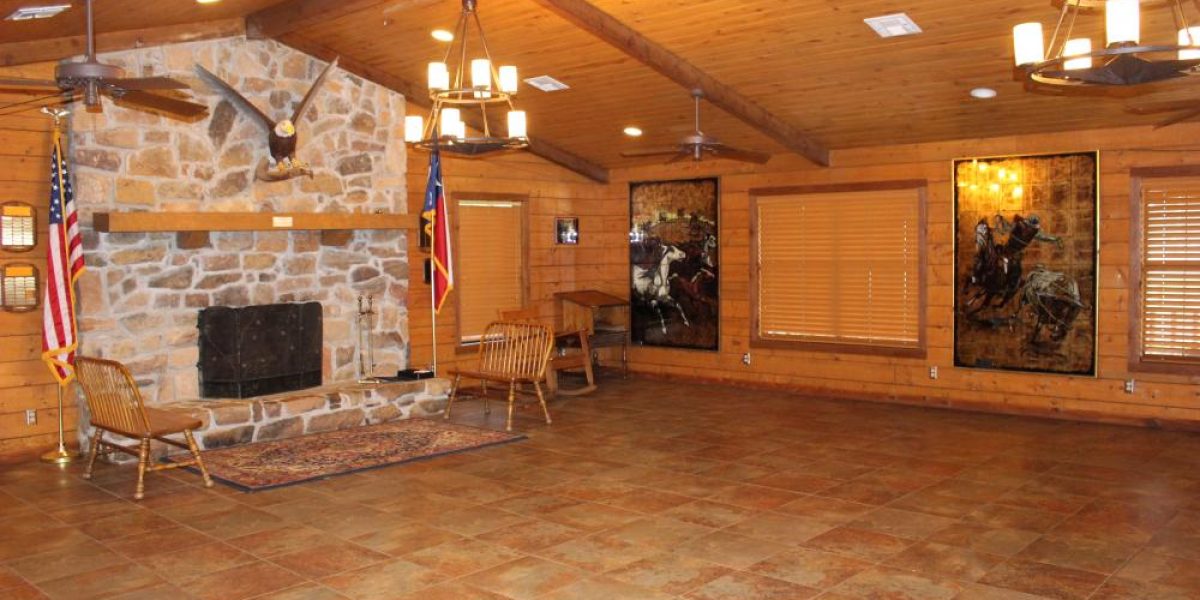
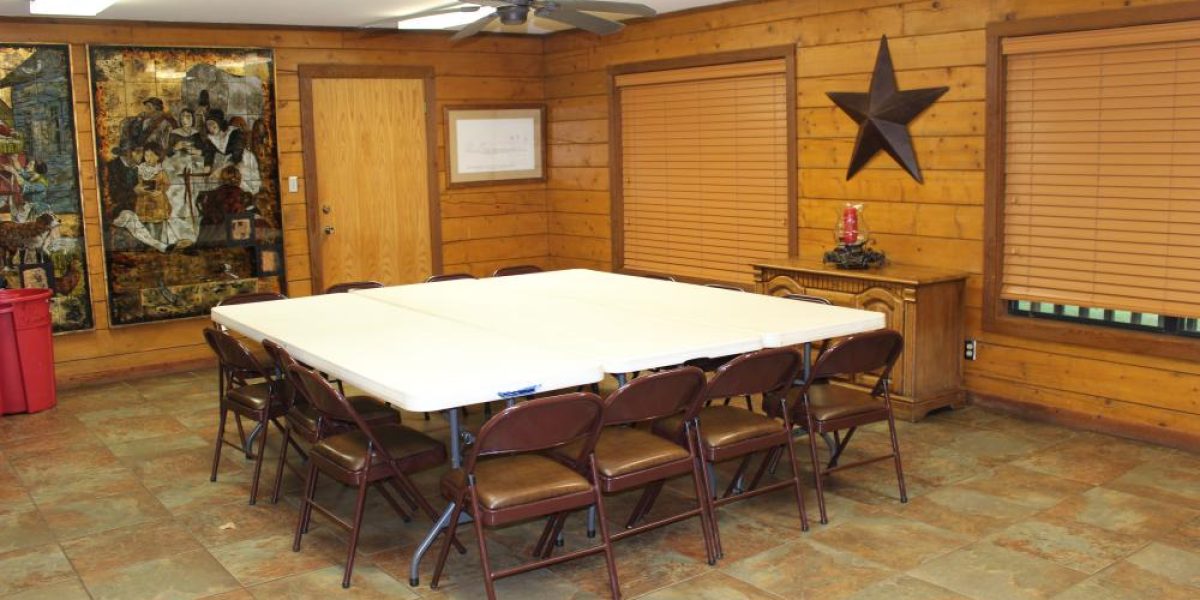
Lewis Railroad Hotel
Following emancipation, African Americans struggled for equality, as public facilities, private businesses and neighborhoods were often segregated. When African Americans did find non-agricultural employment it was primarily for manual labor jobs and for railroads, including brakemen, porters, and construction. The railroad became important to east Texas and transported people, lumber from nearby mills, cotton, cattle, and crops from other states to ports like Houston, Galveston and Beaumont.
The Lewis Railroad Hotel was built about 1870 by John Collins. The two-story frame structure is a modified I-house, built two rooms wide and one room deep, with a full-height entry porch, gable wall chimneys and a later rear addition.
William Lewis purchased the home in 1903 from Mary Collins and lived there with his wife, Viney, and their family. The men in Lewis’ family were laborers, and the women were laundresses.
To supplement his income as a mail carrier, William Lewis opened his home to African American boarders, especially men working on the railroad. The hotel became popular during the 1920s when railroad construction in east Texas increased. As the railroad declined, Lewis took in travelers seeking lodging, as accommodations remained segregated. The hotel became a social gathering place for African Americans.
The hotel converted to apartments in the mid-20th century and continued as a private residence into the 1970s. After a period of vacancy and identification as an endangered property, the city of San Augustine acquired this significant resource for the benefit of the public and the preservation of an important chapter of history.
You May Also Like
History
As one of the oldest cities in Texas, San Augustine has worked tirelessly to preserve its rich history. Visit today to view historical sites all around our city.
Parks
Texas is a beautiful place to live, and in San Augustine, we relish the lush green forests that are native to our area. Take a stroll through one of our amazing parks today!
Events
We know how to have a good time here in San Augustine! From festivals to museum exhibits, we keep the community calendar packed with fun activities for the whole family.
Vineyards
Texas wine is where it’s at, and East Texas is just bursting with vineyards that produce really wonderful vintages. Not to mention the local breweries as well! Schedule your tour today!
